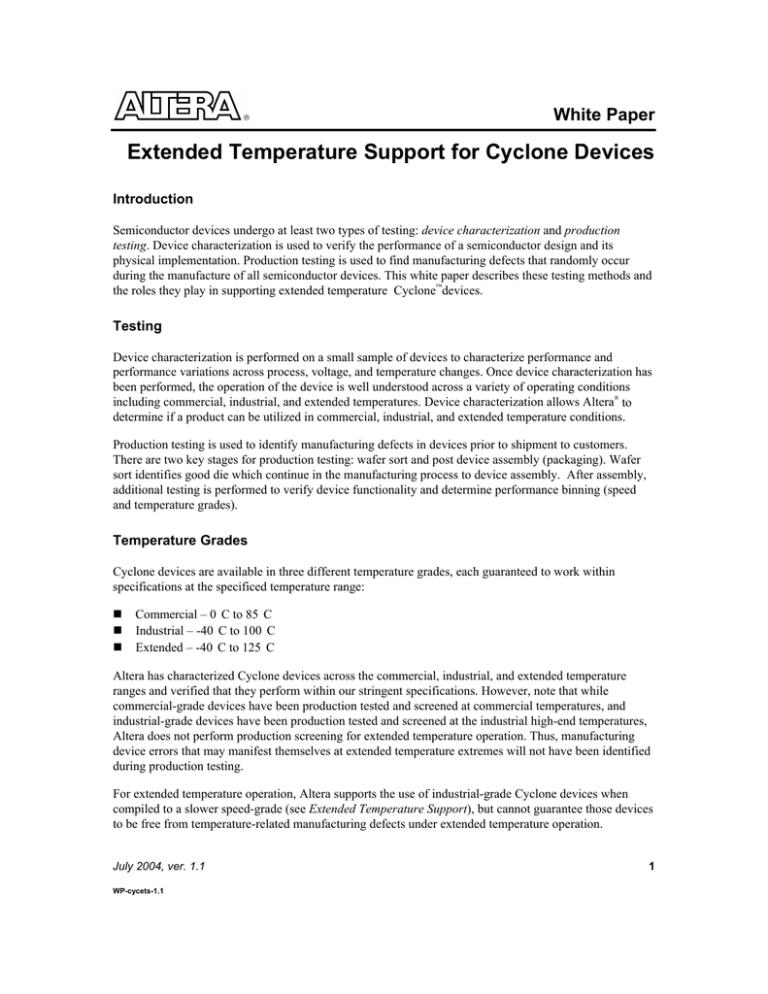
White Paper
Extended Temperature Support for Cyclone Devices
Introduction
Semiconductor devices undergo at least two types of testing: device characterization and production
testing. Device characterization is used to verify the performance of a semiconductor design and its
physical implementation. Production testing is used to find manufacturing defects that randomly occur
during the manufacture of all semiconductor devices. This white paper describes these testing methods and
the roles they play in supporting extended temperature Cyclone™devices.
Testing
Device characterization is performed on a small sample of devices to characterize performance and
performance variations across process, voltage, and temperature changes. Once device characterization has
been performed, the operation of the device is well understood across a variety of operating conditions
including commercial, industrial, and extended temperatures. Device characterization allows Altera® to
determine if a product can be utilized in commercial, industrial, and extended temperature conditions.
Production testing is used to identify manufacturing defects in devices prior to shipment to customers.
There are two key stages for production testing: wafer sort and post device assembly (packaging). Wafer
sort identifies good die which continue in the manufacturing process to device assembly. After assembly,
additional testing is performed to verify device functionality and determine performance binning (speed
and temperature grades).
Temperature Grades
Cyclone devices are available in three different temperature grades, each guaranteed to work within
specifications at the specificed temperature range:
Commercial – 0 C to 85 C
Industrial – -40 C to 100 C
Extended – -40 C to 125 C
Altera has characterized Cyclone devices across the commercial, industrial, and extended temperature
ranges and verified that they perform within our stringent specifications. However, note that while
commercial-grade devices have been production tested and screened at commercial temperatures, and
industrial-grade devices have been production tested and screened at the industrial high-end temperatures,
Altera does not perform production screening for extended temperature operation. Thus, manufacturing
device errors that may manifest themselves at extended temperature extremes will not have been identified
during production testing.
For extended temperature operation, Altera supports the use of industrial-grade Cyclone devices when
compiled to a slower speed-grade (see Extended Temperature Support), but cannot guarantee those devices
to be free from temperature-related manufacturing defects under extended temperature operation.
July 2004, ver. 1.1
WP-cycets-1.1
1
Extended Temperature Support for Cyclone Devices
Altera Corporation
Performance as a Function of Temperature
An important aspect of semiconductor device operation is that its performance is inversely correlated to
operating temperature. Estimates identified through characterization of Altera Cyclone devices indicate a
fraction of a percent reduction of fMAX change per degree C. Thus, at higher temperatures the fMAX is
decreased while at lower temperatures the fMAX increases. This characteristic is automatically taken into
account in Altera software when implementing a design on a specific device, speed-grade combination
such that across its intended operating temperature range (for example 0 C to 85 C for commercial
operation), adequate timing margin is included so that no timing violations occur in synchronous designs.
Extended Temperature Support
Extended temperature operation requires additional timing margin over industrial temperature operation to
compensate for the potential increased variation of fMAX. With Altera devices, increased timing margin is
achieved by compiling the design to a slower speed-grade in Quartus® II. For example, one can increase
timing margin for a -6 device by utilizing a -7 device setting in Quartus II. This technique can be utilized to
increase the timing margin of an industrial device to meet the constraints of extended temperature range
operation (see the “Using Extended Temperature Devices in the Quartus II Software” whitepaper for more
information). A specific list of industrial-grade Cyclone devices supporting extended temperature
operation when compiled to a slower speed-grade is posted at www.altera.com.
Copyright © 2004 Altera Corporation. All rights reserved. Altera, The Programmable Solutions
Company, the stylized Altera logo, specific device designations, and all other words and logos
101 Innovation Drive
San Jose, CA 95134
(408) 544-7000
www.altera.com
that are identified as trademarks and/or service marks are, unless noted otherwise, the
trademarks and service marks of Altera Corporation in the U.S. and other countries.* All other
product or service names are the property of their respective holders. Altera products are
protected under numerous U.S. and foreign patents and pending applications, maskwork
rights, and copyrights. Altera warrants performance of its semiconductor products to current
specifications in accordance with Altera’s standard warranty, but reserves the right to make
changes to any products and services at any time without notice. Altera assumes no
responsibility or liability arising out of the application or use of any information, product, or
service described herein except as expressly agreed to in writing by Altera Corporation. Altera
customers are advised to obtain the latest version of device specifications before relying on
any published information and before placing orders for products or services.
2

